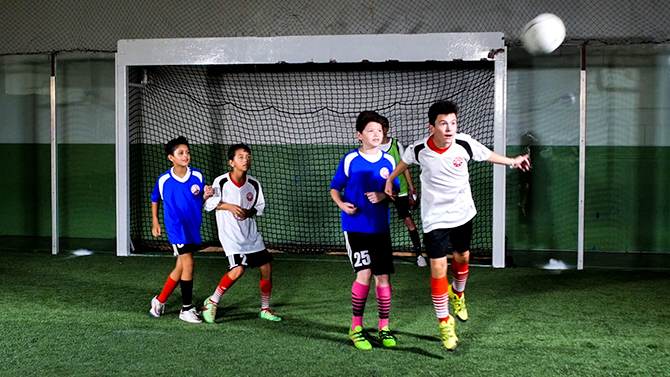


Safe soccer heading
Photo courtesy of NSCAA September 16, 2016
Kaminski spearheads safe soccer heading course for national organization
The beautiful game. Soccer is beloved for its creativity, fluidity and spectacular moments. A perfect header – whether it be a diving goal or a timely clear – can be that moment of splendor.
But the aerial battles for headers, especially at the sport’s highest levels of competition, are notoriously rough, occasionally bloody and, although rarely, can result in concussive levels of head impact.
At the youth level, American parents are naturally concerned that a collision will result in the scary scenario for their children. Additionally, many youth coaches aren’t grizzled soccer veterans but instead parent volunteers who want their children to stay active and learn the lessons of teamwork.
To help give coaches and parents the tools necessary to teach the skill properly, University of Delaware athletic training researcher Tom Kaminski was at a congressional briefing in Washington, D.C., this week to explain a new interactive training course.
The kinesiology and applied physiology professor’s research on head impacts in soccer dates back nearly two decades, well before the media microscope centered on concussions in sports.
For the past year, Kaminski worked with the National Soccer Coaches Association of America (NSCAA), the world’s largest organization of its kind, to develop the content and create interactive lessons. The course is called Get aHEAD Safely in Soccer and takes under 45 minutes to complete.
“Eliminating head injuries in soccer is likely impossible, but reducing exposure to injury and, therefore, enhancing player safety is definitely [possible],” said Ian Barker, director of coaching education for NSCAA.
The U.S. Soccer Federation recently banned heading for players under the age of 10. The move is seen as precautionary. No hard evidence exists for or against the claim that the act of purposeful heading causes concussions. Most of the time, a concussion occurs because of an elbow, head-to-head contact or an errant clear that hits a player in the head.
Kaminski’s worry is that with the ban for those under 10, what happens when players start heading the ball at 11 with little to no practice?
“The foundation of preventing injury is through neck and core strengthening exercises,” said Kaminski at a congressional briefing. “When we teach 11- to 13-year-olds how to unite their torso, neck and head, they will protect themselves from injury. You could say we prevent the ‘bobble head’ effect.”
The full course is live at this NSCAA website and is completely free of charge.
Others who attended the briefing included Hank Steinbrecher, the secretary general of U.S. Soccer; U.S. Rep. Tom Rooney (R-Florida); Lynn Berling-Manuel, CEO of the NSCAA; and Ian Barker, NSCAA director of coaching education.
Contact Us
Have a UDaily story idea?
Contact us at ocm@udel.edu
Members of the press
Contact us at 302-831-NEWS or visit the Media Relations website

